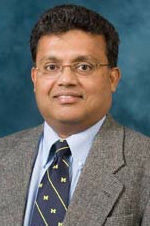

 Anthony M. Waas Anthony M. WaasProfessor, Department of Aerospace Engineering, University of Michigan Anthony M. Waas, Professor of Aerospace Engineering and Mechanical Engineering (courtesy) and Director, Composite Structures Laboratory at the University of Michigan, received his B.Sc. with first class honors from Imperial College, Univ. of London, U.K., in 1982, the M.S. in 1983 and Ph.D in 1988 with a minor in Applied Mathematics from the California Institute of Technology, all in Aeronautics. He joined the faculty of the Department of Aerospace Engineering at the University of Michigan in 1988, where he was promoted to the rank of Associate Professor in 1994 and Professor in 2000. His current research interests include mechanics of composite structures and composite materials including failure mechanics, energy absorption and mitigation, structural stability, biomechanics, "hot" structures and nano-scale composite materials. He currently serves as an academic consultant to the structures team of the NASA Engineering Safety Board, and is the technical chair for the AIAA SDM conference, 2008. Dr. Waas has served as a member of the AIAA Structures Technical Committee (1991–1994, 1997–00, 02–present), the ASME Technical Committee on Instability of Solids and Structures (1995–present), the ASME Technical Committee on Experimental Mechanics (1996–00) and the ASME Structures and Materials Committee (1998–present). He was the chair of the latter committee (2003–2005). He is a recipient of the Royal Aeronautical Society Prize of Imperial College (1982), the William Balhaus Prize in Aeronautics at the California Institute of Technology (1988), a Rackham Faculty Fellowship (1990), University of Michigan Aerospace Department Teaching Award (1995), the Society of Automotive Engineers Ralph Teetor Award (1995), the American Academy of Mechanics Junior Award for Research (1997), University of Michigan Aerospace Department Research Award (1998) and the University of Michigan Aerospace Department Outstanding Accomplishment Award (2001). Recently, he received the David Liddle award for Research at UM (2006) and an AIAA sustained service award (2006). He is a Fellow of ASME and a Fellow of the American Academy of Mechanics. He has served as an Associate Editor of the AIAA Journal (1995–02) and on the Editorial Advisory Board of the AIAA Journal of Aircraft (1995–00). He is currently an Associate Editor of the ASME Journal of Applied Mechanics, is on the editorial board of the Journal Composites: B, is an Associate Editor of the Royal Aeronautical Society, UK, Aeronautical Journal, is on the Editorial Board of Computer Modeling in Engineering and Sciences, is on the editorial boards of the International Journal of Engineering Science and the Journal of the Mechanical Behavior of Materials. At the University of Michigan, he served on the Advisory Board in Control of Intercollegiate Athletics (1999–2002), as the chairperson of the College of Engineering Rules Committee (1995–1998), and as chair of the College of Engineering Honors and Awards Committee, 2004. He served as the Aerospace Department Graduate Program Chair (1998–2002), the Associate Chairperson of the Aerospace Engineering Department (2003–2005), and currently serves on the College of Engineering executive committee. He is author or co-author of more than 100 refereed journal papers, and numerous conference papers and presentations. Abstract: On the Dynamic Buckling of Impacted Slender Structures Dynamic buckling or dynamic instability of thin-walled structures under impulsive loading has received much attention in the past. Most investigations, either theoretical or experimental, were devoted to examining the conditions under which dynamic buckling or dynamic instability of the structural system occurred, with the goal of defining a criterion or a set of criteria that can be used for purposes of design. Here we revisit this problem to examine the notion of a critical time to buckle, a notion that has been discussed in the past with respect to understanding the temporal evolution of the buckling pattern that results from dynamic buckling. A new concept, a critical time to buckle, associated with a dynamic bifurcation condition will be presented and results from experiments will be used to illustrate this notion and clarify the different sets of criteria that have been introduced to assess dynamic buckling.
|
| + Home + Events + Program + Photos & Videos! + Speakers + Travel & Accommodations + GALCIT Home
|